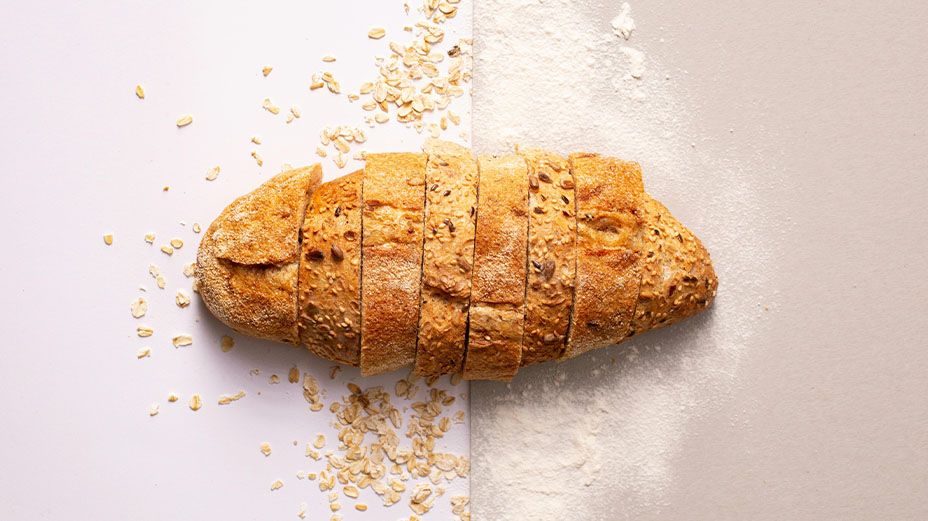Minerals, vitamins and properties of whole wheat flour or whole wheat flour are so much that bread prepared with whole wheat flour is known as a healthy and complete food.
If you want to benefit from the properties of wheat flour (in English: Wheat Flour), you should use whole wheat or bran flour. Consuming whole wheat flour can reduce problems such as anemia, mineral deficiency, gallstones, breast cancer, chronic fatigue, obesity, weakness and weakness, tuberculosis, problems during pregnancy and breastfeeding, and reduce the possibility of infertility.
Since wheat germ has about 3 times more vitamin B than wheat, its consumption is used to reduce digestive tract problems, skin diseases, respiratory and cardiovascular diseases, and helps to balance cholesterol levels and protect the heart.
Types of wheat flour
Whole wheat flour or whole wheat flour: flour that is produced by pulverizing the whole grain of wheat without any processing and contains high fiber. The best way to ensure that wheat flour is complete is to prepare wheat grains and take them to the mill to make flour for you.
Wheat germ flour: flour obtained by drying and pulverizing sprouted wheat and contains high fiber.
Semolina flour: Semolina flour is special for preparing pasta and is made from a special type of wheat called durum. The particles of this flour are coarser than other flours and it has more protein, but it is bran-free.
White flour: flour from which the wheat husk or wheat bran has been separated and is prepared only from the inner price or wheat starch and is without fiber. The degree of separating bran from white flour has different degrees depending on its use.
White flours used to prepare bread, especially stone bread and biscuits, contain a small amount of wheat bran, but all types of confectionery flour have the lowest amount of bran among white flours, especially the flour used to produce zolbia and okra, which is called grade flour. 1 Confectionery or three stars is famous as wheat bran is separated from it as much as possible.
Each 100 grams of wheat contains the following nutrients:
340 calories
Dietary fiber 13.1 grams
Protein 9.6 grams
Carbohydrate 74.78 grams
Fat 1.2 grams
Niacin or vitamin B3 5.347 mg equivalent (33% of daily requirement)
Thiamine or vitamin B1 0.297 mg (25%)
Pantone acid or vitamin B5 1.011 mg (20 percent)
Riboflavin or vitamin B2 0.188 mg (14%)
Pyridoxine or vitamin B6 0.191 mg (11%)
Folate or vitamin B9 28 micrograms (7%)
Choline 31.2 mg (6%)
Manganese 3.399 mg (148 percent)
Copper 0.475 mg (53%)
Zinc 2.96 mg (27 percent)
Selenium 12.7 micrograms (23%)
Iron 3.71 mg (21%)
Potassium 394 mg (16%)
Magnesium 117 mg (9%)
Phosphorus 323 mg (7%)
Properties of whole wheat flour
When talking about the properties of wheat flour for the body and its benefits, it actually refers to the properties of whole wheat flour, most of the useful nutrients and vitamins of wheat are in its bran, and separating the bran leaves the starchy part and A very important part of the properties of wheat is lost.
In industrial terms, wholemeal flour is called flour whose bran content is less than 15%. Wholemeal flour has a dark color and is known as whole wheat flour, which is why it is so popular.
Wheat bran is known to be an effective treatment for patients suffering from chronic constipation and colon disorders. Since the flour used in the food industry is bran-free and even what is known as bran has a very low bran percentage, wheat bran is packaged and sold separately.
According to researchers, wheat bran is the richest natural food source of fiber and fibers needed for the overall health of the body and digestive system. Consuming whole wheat flour or wheat bran can have many health benefits for the body, including:
Enriched wheat flour, importance of wheat flour, whole wheat flour
Properties of whole wheat flour
– Rich in fiber and nutrients
– Prevention of premature aging
– Prevention and reduction of cardiovascular diseases
– Prevention of coronary artery occlusion disease
– Reduction of colon and rectal cancer
– Improve metabolism
– Obesity control
– Prevention of type 2 diabetes
– Reduction of chronic inflammation
– Prevention of gallstones
– Improve bowel movements
– Prevention of childhood asthma
– Reduction of menopause symptoms
Properties of wheat flour for children
To benefit from the properties of wheat flour for children, especially babies, you should try to use whole wheat flour or wheat germ flour.
The best way to use wheat flour for your beloved baby or child is to make porridge with wheat flour.
Mix 1 tablespoon of whole wheat flour with 2 cups of milk and stir constantly on low heat until it thickens.
If you want to prepare porridge for babies, you don’t need any other additives, but to add more flavor to the porridge after thickening, you can add 50 grams of butter, 1 pinch of salt and 1 tablespoon of sugar to it and mix the sugar and melted butter. and remove from heat.
Properties of wheat flour for the skin
Wheat flour has brightening properties for the skin and you can use it in the combination of various skin brightening and whitening masks.
Wheat flour helps the natural fat of the skin to return and you have white and clear skin.
Wheat flour body scrub
You can use the wheat flour body scrub to exfoliate the skin and brighten the overall skin color. Mix 2 tablespoons of flour with 1 spoon of sandalwood powder
Wholemeal flour is flour that has been obtained by milling wheat grains, that is, all the above components without any additions or omissions
Wheat has three outer layers, the husk, the aleurone layer and the endosperm, and the wheat husk accounts for 9%, the aleurone 8%, and the endosperm 80% of the dry weight of wheat, and the other 3% is related to the wheat germ, which is There are long sides of the wheat grain.
The main part of the wheat husk is cellulose or fiber, which, in addition to B vitamins, contains 3% of minerals such as iron, zinc, magnesium and calcium, but 18% of vitamins and 9% of lipid (fatty) substances are hidden in the structure. Wheat is present in the aleurone layer.
Wheat germ also has 36% protein in its structure and is rich in fats and B group vitamins.
Wholemeal flour:
This flour is prepared from all components of wheat grain (endosperm, bran and germ) after initial peeling. The degree of extraction and the high percentage of bran (2-6% bran extraction) make this flour have the highest nutritional value. Bran forms the outer wall of wheat, and this part of wheat has large amounts of fiber, minerals and vitamins.
Wholemeal bread:
Wholemeal bread is bread made from wholemeal flour, which is the main ingredient of the dough.
It is interesting to know that the whole bread is the color of wheat grains (golden), it has a better and longer shelf life
Health benefits of baking with wholemeal flour
Fiber is the main reason for consuming wholemeal flour. Adults need 25 to 35 grams of fiber per day, which is very good for your health.
The fiber in wholemeal flour can help move food through your digestive system, improve digestion, and help prevent constipation. Foods with fiber include wheat, whole grain bread, whole grains, brown rice, legumes, carrots, cucumbers and tomatoes.
1- Improve digestion
Whole grains also have other digestive benefits. The fiber content in whole grains keeps bowel movements regular and helps prevent diverticulosis, a condition in which small pouches form in the lining of the large intestine, causing inflammation, diarrhea, and pain. Whole grains also contain lactic acid, which increases the “good bacteria” in the colon (preventing bloating). These bacteria improve digestion and also strengthen the absorption of nutrients and the body’s immune system.
2- Reducing the risk of heart diseases
Whole grains not only help prevent bad cholesterol from being absorbed into your body, but they also lower triglycerides, both of which are major risk factors for heart disease. Whole grains reduce the risk of heart disease overall. One study found that women who consumed 2 to 3 servings of whole grain products per day were 30 percent less likely to have a heart attack or die from heart disease than women who consumed less than one serving per week.
3- Lower blood pressure
The heart benefits of whole grains don’t stop with cholesterol and triglycerides. They also reduce blood pressure, which is one of the most important risk factors for heart disease. One study found that men who ate more than seven servings of whole grains per week had a 19 percent lower risk of developing high blood pressure than men who ate one or less. Studies in women show similar benefits.
4- Control the weight
People who eat more whole grains are more likely to maintain a healthy weight and less likely to gain weight over time than people who eat refined grains. In one study, women who ate the most wheat germ, brown rice, whole-wheat bread, and other whole grains had a 49 percent lower risk of weight gain over time compared to women who ate the most white bread. Over a 12-year period, middle-aged men and women who ate a high-fiber diet gained 3.35 pounds less weight than those who followed refined foods.
5- Redistribute the fat
Even though eating whole grains won’t directly cause you to lose weight, studies have shown that including whole grains as a major part of your diet can help you lose body fat and promote healthy fat distribution. Eating whole grains can reduce belly fat, or what scientists call “central obesity.” Too much belly fat increases the risk of diabetes and other health problems.
6- Feel full
One of the ways whole grains can help you control your weight is by making you feel fuller than refined grains like cookies or white bread. According to Ganz, the author of the book, the diet with small changes, “whole grains are digested and have a more satiating effect.”
7- Regulation of blood sugar
One of the main benefits of whole grains is that they help prevent your blood glucose from spiking, which can lower your risk of developing type 2 diabetes. In one study, women who ate 2 to 3 servings of whole grains per day were 30 percent less likely to develop diabetes than women who consumed only whole grain products. One analysis also found that people who ate 3 or more servings of whole grains per day had a 32 percent lower risk of developing diabetes than those who ate refined grains. Eating whole grains has been shown to have a positive effect on type 2 diabetes, so they are a great choice for people with prediabetes or high risk of diabetes.
8- Provide vitamin C and group B vitamins
Like calcium, whole grains aren’t your first source of vitamin C, but you can get it from some foods




